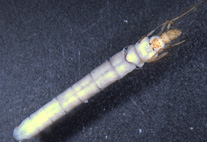Abstract
The thirty known species of Oragua are distributed from southern Mexico to Argentina. Seventeen species are recorded from Brazil, but only O. elegantula Young, 1977, O. insipida Young, 1977, and O. jurua Young, 1977 are recorded from Amazonas State. Oragua partitula (Jacobi, 1905) is herein firstly recorded from Brazil, ocurring in Amazonas State. The aim of the study was to describe eight new species of Oragua, to provide a key to males of the species of the genus that are recorded from Amazonas State and to study in detail the female terminalia of these new species. Also, the female of O. jurua Young, 1977 is herein described for the first time. Oragua alerochae sp. nov. has the external color pattern similar to O. bifasciata Cavichioli, 2000, however, the head is darker, the forewings are paler and the stripes are thinner, aedeagus is much more curved with long apical processes, and apex of paraphyses rami are curved. Oragua aurantimaculata sp. nov. is similar externally to O. elegantula and Oragua jau sp. nov. as they share the body brown with three orange maculae on crown and orange maculae on forewings, but it has the aedeagus with shaft enlarged medially with a pair of apical processes curved anteriorly and connective more slender. Oragua bella sp. nov. is dark with orange spots, aedeagus with basal elongated processes extending to the apex of the pygofer, with the basal portion enlarged and narrowing toward the apex. Oragua copiosa sp. nov. is dark with small pale dots all over the body, paraphyses rami are slender and their apices expanded, and styles with hooked apex, extending posteriorly beyond the connective apex. Oragua gracilenta sp. nov. has the external color similar to O. galerula, but it can be distinguished by the brown ground color, absence of two maculae near median line just before posterior margin on pronotum and apex of rami of paraphyses bifurcate and not truncate. Oragua jau sp. nov. has the external color similar to O. elegantula, but the aedeagus is curved and slender with a pair of small lateral processes at the apex and very thin paraphyses rami bifurcating only in the final portion, with the length of the rami just one third of the total length. Oragua schwertineri sp. nov. has the external color similar to O. insipida, however the male genitalia differs from the latter by the lack of paraphyses and aedeagus with pair of basal processes curved dorsally and shaft with pair of apical lateral processes. Oragua unifasciata sp. nov. is dark brown with pale spots over the body with a pale transverse stripe over the anteapical cells and paraphyses stem slender and abruptly broadened at apical two thirds, with rami robust and flattened with posterior margin serrate with large and irregular tooth-like projections. This work raises the number of Oragua species occurring in Amazonas State from three to twelve.

